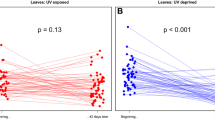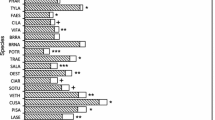Summary
The unprecedented rate of depletion of the stratospheric ozone layer will likely lead to appreciable increases in the amount of ultraviolet-B radiation (UV-B, 280–320 nm) reaching the earth's surface. In plants, photosynthetic reactions and nucleic acids in the mesophyll of leaves are deleteriously affected by UV-B. We used a fiber-optic microprobe to make direct measurements of the amount of UV-B reaching these potential targets in the mesophyll of intact foliage. A comparison of foliage from a diverse group of Rocky Mountain plants enabled us to assess whether the foliage of some plant life forms appeared more effective at screening UV-B radiation. The leaf epidermis of herbaceous dicots was particularly ineffective at attenuating UV-B; epidermal transmittance ranged from 18–41% and UV-B reached 40–145 μm into the mesophyll or photosynthetic tissue. In contrast to herbaceous dicots, the epidermis of 1-year old conifer needles attenuated essentially all incident UV-B and virtually none of this radiation reached the mesophyll. Although the epidermal layer was appreciably thinner in older needles (7 y) at high elevations (Krumholtz), essentially all incident UV-B was attenuated by the epidermis in these needles. The same epidermal screening effectiveness was observed after removal of epicuticular waxes with chloroform. Leaves of woody dicots and grasses appeared intermediate between herbaceous dicots and conifers in their UV-B screening abilities with 3–12% of the incident UV-B reaching the mesophyll. These large differences in UV-B screening effectiveness suggest that certain plant life forms may be more predisposed than others to meet the challenge of higher UV-B levels resulting from stratospheric ozone depletion.
Similar content being viewed by others
References
Baig MN, Tranquillini W (1976) Studies on upper timberline: morphology and anatomy of Norway spruce (Picea abies) and stone pine (Pinus cembra) needles from various habitat conditions. Can J Bot 54:1622–1632
Barnes PW, Flint SD, Caldwell MM (1987) Photosynthesis damage and protective pigments in plants from a latitudinal arctic/alpine gradient exposed to supplemental UV-B radiation in the field. Art Alp Res 19:21–27
Blumthaler M, Ambach W (1990) Indication of increasing solar ultraviolet-B radiation flux in alpine regions. Science 248:206–208
Bornman JF (1989) Target sites of UV-B radiation in photosynthesis of higher plants. J Photochem Photobiol B: Biology 4:145–158
Bornman JF, Vogelmann TC (1988) Penetration of blue and UV radiation measured by fiber optics in spruce and fir needles. Physiol Plant 72:699–705
Caldwell M, Robberecht R, Nowak RS, Billings WD (1982) Differential photosynthetic inhibition by ultraviolet radiation in species from the arctic-alpine life zone. Arc Alp Res 14:195–202
Caldwell MM, Gold WG, Harris G, Ashurst CW (1983a) A modulated lamp system for solar UV-B (280–320 nm). Supplementation studies in the field. Photochem Photobiol 37:479–485
Caldwell M, Robberecht R, Flint SD (1983b) Internal filters: Prospects of UV-acclimation in higher plants. Physiol Plant 58:445–450
Caldwell MM, Teramura AH, Tevini M (1989) The changing solar ultraviolet climate and the ecological consequences for higher plants. Trends Ecol Evol 4:363–367
Clark JB, Lister GR (1975) Photosynthetic action spectra of trees II. The relationship of cuticle structure to the visible and ultraviolet spectral properties of needles from four coniferous species. Plant Physiol 55:407–413
DeLucia EH, Berlyn GP (1984) The effect of increasing elevation on leaf cuticle thickness and cuticular transpiration in balsam fir. Can J Bot 62:2423–2431
DeLucia EH, Day TA, Vogelmann TC (1992) Ultraviolet-B radiation and the Rocky Mountain environment: measurement of incident light and penetration into foliage. Current Topics Plant Biochem and Physiol 10:32–48
Dorn RD (1977) Manual of vascular plants of Wyoming. Vols 1&2, Garland Publ, New York, USA
Flint SD, Jordan PW, Caldwell MM (1985) Plant protective response to enhanced UV-B radiation under field conditions: leaf optical properties and photosynthesis. Photochem Photobiol 41:95–99
Gausman RW, Rodriguez RP, Escobar DE (1975) Ultraviolet radiation reflectance, transmittance, and absorbance by plant leaf epidermises. Agron J 83:391–396
Hansen-Bristow K (1986) Influence of increasing elevation on growth characteristics at timberline. Can J Bot 64:2517–2523
Haupt W, Scheuerlein R (1990) Chloroplast movement. Plant, Cell Environ 13:595–614
Iwanzik W, Tevini M, Dohnt G, Voss M, Weiss W, Gräber O, Renger G (1983) Action of UV-B radiation on photosynthetic primary reactions in spinach chloroplasts. Physiol Plant 58:401–407
Kerr RA (1991) Ozone destruction worsens. Science 252:204
Kerr RA (1992) New assaults seen on earth's ozone shield. Science 255:797–798
Knapp AK, Vogelmann TC, McClean TM, Smith WK (1988) Light and chlorophyll gradients within Cucurbita cotyledons. Plant, Cell Environ 11:257–263
McClure JW (1986) Physiology of flavonoids in plants. In: V Cody, E Middleton, JB Harborne (eds) Plant flavonoids in biology and medicine: biochemical, pharmacological, and structure-activity relationships. Alan Riss pp 77–85
Pang Q, Nays JB (1991) UV-B inducible and temperature-sensitive photoreactivation of cyclobutane pyrimidine dimers in Arabidopsis thaliana. Plant Physiol 95:536–543
Robberecht R, Caldwell MM (1978) Leaf epidermal transmittance of ultraviolet radiation and its implications for plant sensitivity to ultraviolet-radiation induced injury. Oecologia 32:277–287
Robberecht R, Caldwell MM (1983) Protective mechanisms and acclimation to solar ultraviolet-B radiation in Oenothera stricta. Plant, Cell and Environ 6:477–485
Robberecht R, Caldwell MM, Billings WD (1980) Leaf ultraviolet optical properties along a latitudinal gradient in the arcticalpine life zone. Ecology 61:612–619
Saito N, Werbin N (1969) Radiation spectrum for a DNA-photoreactivating enzyme isolated from higher plants. Radiat Bot 9:421–424
SAS (1990) SAS/STAT User's Guide, Statistics. Version 6, Fourth Ed, Vol 2, SAS Institute, Cary, NC, USA
Schmelzer E, Jahnen W, Hahlbrock K (1988) In situ localization of light-induced chalcone-synthase mRNA, chalcone synthase, and flavonoid end products in epidermal cells of parsley leaves. Proc Natl Acad Sci 85:2989–2993
Schnabl N, Weissenböck G, Scharf H (1986) In vivo microspectrophotometric characterization of flavonol glycosides in Vicea faba guard and epidermal cells. J Expt Bot 37:61–72
Strack D, Heilemann J, Mömken M, Wray V (1988) Cell wall-conjugated phenolics from Coniferae leaves. Phytochemistry 27:3517–3521
Strack D, Heilemann J, Wray V, Dirks H (1989) Structures and accumulation patterns of soluble and insoluble phenolics from Norway spruce needles. Phytochemistry 28:2071–2078
Sullivan JH, Teramura AH (1989) The effects of ultraviolet-B radiation on loblolly pine. I. Growth, photosynthesis and pigment production in greenhouse-grown seedlings. Physiol Plant 77:202–207
Tevini M, Teramura AH (1989) UV-B effects on terrestrial plants. Photochem Photobiol 50:479–487
Tevini M, Braun J, Fieser G (1991) The protective function of the epidermal layer of rye seedlings against ultraviolet-B radiation. Photochem Photobiol 53:329–333
Vogelmann TC (1989) Penetration of light into plants. Yearly review. Photochem Photobiol 50:895–902
Vogelmann TC, Martin G, Chen G, Buttry D (1991) Fiber optic microprobes and measurement of the light microenvironment within plant tissues. Adv Botanical Res 18:231–270
Weissenböck G, Hedrich, Sachs G (1986) Secondary products in isolated guard cell, epidermal cell and mesophyll cell protoplasts from pea (Pisum sativum L.) leaves: distribution and determination. Protoplasma 134:141–148
Weissenböck G, Schnabl H, Sachs G, Elbert C, Neller FO (1984) Flavonol content in guard cell and mesophyll cell protoplasts isolated from Vicea faba leaves. Physiol Plant 62:356–362
Author information
Authors and Affiliations
Rights and permissions
About this article
Cite this article
Day, T.A., Vogelmann, T.C. & DeLucia, E.H. Are some plant life forms more effective than others in screening out ultraviolet-B radiation?. Oecologia 92, 513–519 (1992). https://doi.org/10.1007/BF00317843
Received:
Accepted:
Issue Date:
DOI: https://doi.org/10.1007/BF00317843




